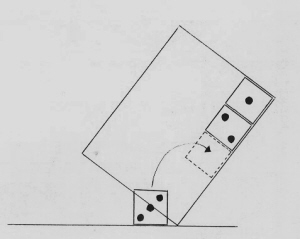 |
 |
Page 37 Fall 1987
|
TIPS & TRICKS Dice stacking by
Emory Kimbrough Is it possible to place four dice on a table, swing an inverted dice cup in rapid arcs across the table so that the cup's rim knocks the dice into the cup, suddenly stop the cup and leave all four dice perfectly stacked?
With
a short physics lesson and a lot of practice anyone can. First,
though, the necessary props must be chosen. Most dice are
unsatisfactory. You will need 3/4" casino dice, sometimes known
as
Select a leather dice cup with a depth of about 3-1/4". If the dice are stacked inside the cup, the top of the stack should be 1/8" to 1/2" below the rim. Diameter is less critical, but look for a cup with roughly a 21/2" mouth. Many cups have ribbed walls and a trip lip. These features prevent dishonest gamblers from using controlled dice shots and they will also defeat all attempts to stack dice.
Satin finish casino dice and a sturdy smooth-walled cup are available from AI's Magic Shop, Washington DC.
Find
a large smooth surface such as a glass table or formica counter.
Place the dice at least three inches apart in a row perpendicular to
your body. Grasp the cup mouth-down with your right hand. Your index
finger should be on top with your thumb and other fingers on the
sides. Tilt the cup away from you at about a 45-degree angle and
start with the cup between you and the first die.
Swing the cup back and forth in an arc, always keeping one point on the far side of the rim in contact with the table. The arc should be about 15 inches wide, and the cup always tilted away from you.
When
you feel brave, swing the cup farther so that you knock the first
die into the cup on a right- to-left sweep (illus. 1).
Since
you are swinging in an arc rather than a straight line and because
you always keep the cup tilted away from you at about 45 degrees,
the die will be centrifuged to the top of the cup and remain there.
If you are doing this correctly, you can lift the cup off the table
and, while swinging it, peek into the cup to see how the die remains
in about the same spot.
Pick up the remaining three dice in exactly the same way. The centrifugal force combined with the curved wall of the cup will constrain the four dice to line up as shown in illustration 2. Beginners should pick up one die on every fourth right-toleft swing. Work
toward picking up one die on each swing, including left-to-right.
Just like juggling machetes, the hard part is stopping. Finish with a sharp swing from near left to far right. The cup should stop suddenly with its rim flush with the surface. After 50 or 60 tries, you will finally learn how to leave the dice stacked against the cup's wall on the right side. Before revealing the stacked dice, you should gently slide the cup a bit to the right to avoid toppling the stack when you lift the cup.
Dice stacking, like three-ball juggling, allows for many variations. After picking up the first die, spot the number on its bot tom face as you swing the cup far to the right. Since the opposite faces of a die add to seven, you can call the number on the top of the stack before you lift the cup. A jumbo die or other surprise can be secretly loaded under the cup while the audience's attention is still on the justrevealed stack. It is possible, though extremely difficult, to disassemble the stack by picking off one die at a time with the swinging cup.
To explore these and other possibilities, pick up the books "How to Stack Dice for Fun and No Profit" by Clark Crandall, "Zack Stacks" by Jim Zachary, and "Dice Dexterity" by Audley V. Walsh at a magic store. (Emory
Kimbrough is active in the performing arts of juggling , magic
and comedy. Residing in |
 |
 |